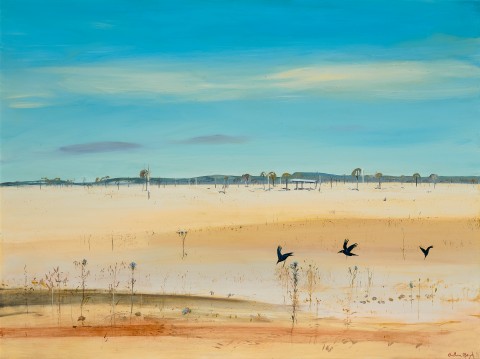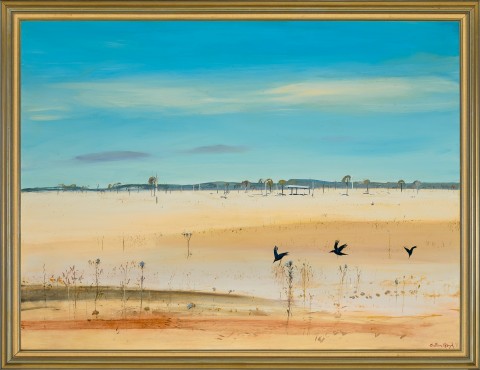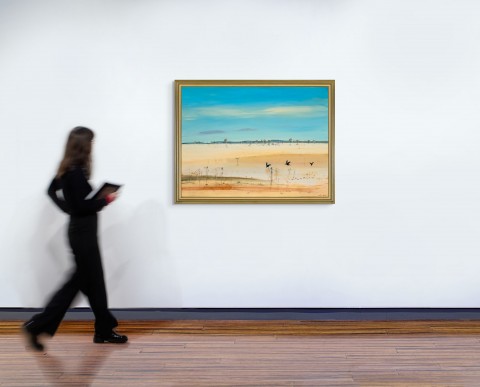WIMMERA LANDSCAPE, c.1982
ARTHUR BOYD
oil on composition board
90.0 x 120.0 cm
signed lower right: Arthur Boyd
Calvary Hospital Auxiliary, Canberra
Private collection, Canberra, acquired from the above in January 1983
Estate of the above, Victoria
Calvary Hospital Art Exhibition, Calvary Hospital, Canberra, 1982, cat. 34
An untiring and extremely skilful painter of landscapes, Arthur Boyd is undoubtedly among Australia’s most revered artists with his highly personalised images of his homeland now iconic within the national consciousness. Among the more revelatory and widely acclaimed of his achievements, the extended sequence of luminous, sun-parched landscapes inspired by his travels to the Wimmera region in north-west Victoria are particularly celebrated. As Janet McKenzie elaborates, ‘…[in these paintings] Boyd created an archetypal Australian landscape. Possessing both a poetic lyricism and a down to earth quality and capturing the glorious light, these works… [offer] a sense of acceptance that many country-dwelling Australians could identify with.’1
Boyd first encountered the Wimmera region during the summer of 1948 – 49 when he accompanied the poet Jack Stevenson on a number of expeditions to Horsham in north-west Victoria. With its flat, semi-arid paddocks and endless horizons, the wheat-farming district presented Boyd with such a stark contrast to the verdant, undulating hills of Berwick and Harkaway (where he had recently undertaken an expansive mural series of Brughelesque idylls at his uncle’s property, ‘The Grange’) that he found himself required to develop a new visual vocabulary in order to capture this desolate landscape. Although the Wimmera could not be described as ‘uninhabitable’, it was for Boyd, his first glimpse of the vastness of Australia’s interior. As Barry Pearce notes, ‘…He discovered there a hint of something that had drawn other painters of his generation, a subject tentatively recorded by a few artists of the nineteenth century and touched on by even fewer of the twentieth: the empty spaces of the great interior. Of course, the Wimmera was wheat country and not by any means forbidding, nor forsaken. But in hot dry weather it could have, over sparse, unbroken horizons, a searing expanse of sky that elicited an acute sense of the infinite…’2
When initially unveiled at the David Jones Gallery in 1950, the Wimmera landscapes were greeted with universal acclaim – no doubt, as more than one author has observed, ‘because their sun-parched colours were so reminiscent of the Heidelberg school.’3 Significantly the paintings resonated not only amongst the public, but also with institutions such as the National Gallery of Victoria who purchased arguably the most famous work from the series, Irrigation Lake, Wimmera, 1950, and the Art Gallery of New South Wales who acquired Midday, The Wimmera, 1948 – 49 – thereby representing the first works by Boyd to enter a major public collection. Imbued with the spirit of the land, these works represented for many their first encounter with these ‘more intimate aspects of the Australian landscape’4 and thus, not only established Boyd’s reputation as ‘an interpreter of the rural Australian environment’5, but moreover, launched his career on the international stage, with Boyd subsequently awarded the honour of representing Australia at the Venice Biennale in 1958.
So profound was the impact of the stark simplicity and golden light of the Wimmera upon Boyd’s psyche that he would subsequently revisit the subject on several occasions over the following decades – whether painting at his property ‘Riversdale’ on the Shoalhaven river in southern New South Wales, or abroad while residing in England and Italy. A later iteration completed during the early 1980s, Wimmera Landscape, c.1982 is one such ‘re-imagining’ of the Wimmera region, illustrating well the complexity of Boyd’s vision which is invariably an amalgam of visual observation, artistic experience and emotional response. Offering a sophisticated reappraisal of the theme in its absolute sparseness, economy of detail and shimmering palette, the image is one of intimacy and warmth, with the radiant glow of the midday sun imparting a sense of joyous optimism. Here there is no angst, no challenge, no dramatic dialogue between man and nature as may be found elsewhere in Boyd’s oeuvre; to the contrary, the work exudes a mood of stillness and calm acceptance, as Franz Philipp astutely observes of such Wimmera paintings ‘…the phrase ‘landscapes of love’ comes to mind.’6
1. McKenzie, J., Arthur Boyd: Art and Life, Thames and Hudson, London, 1967, p. 62
2. Pearce, B., Arthur Boyd Retrospective, The Art Gallery of New South Wales and The Beagle Press, Sydney, 1993, p. 20
3. Campbell, R., ‘Arthur Boyd (1920 – )’, Australia: Paintings by Arthur Streeton and Arthur Boyd, XXIX Biennale, Venice, 1958, n.p.
4. Pearce, op. cit., p. 20
5. Philipp, F., Arthur Boyd, Thames and Hudson, London, 1967, p. 67
6. ibid., p. 64
VERONICA ANGELATOS


